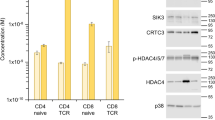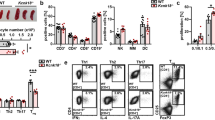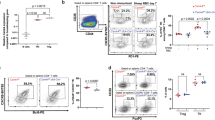Abstract
Calcineurin links calcium signaling to transcriptional responses in the immune, nervous and cardiovascular systems. To determine the function of the calcipressins, a family of putative calcineurin inhibitors, we assessed the calcineurin-dependent process of T cell activation in mice engineered to lack the gene encoding calcipressin 1 (Csp1). Csp1 regulated calcineurin in vivo, and genes triggered in an immune response had unique transactivation thresholds for T cell receptor stimulation. In the absence of Csp1, the apparent transactivation thresholds for all these genes were shifted because of enhanced calcineurin activity. This unbridled calcineurin activity drove Fas ligand expression, which normally requires high T cell receptor stimulation and results in the premature death of T helper type 1 cells. Thus, calcipressins modulate the pattern of calcineurin-dependent transcription, and may influence calcineurin activity beyond calcium to integrate a broad array of signals into the cellular response.
This is a preview of subscription content, access via your institution
Access options
Subscribe to this journal
Receive 12 print issues and online access
$209.00 per year
only $17.42 per issue
Buy this article
- Purchase on Springer Link
- Instant access to full article PDF
Prices may be subject to local taxes which are calculated during checkout





Similar content being viewed by others
Change history
11 March 2024
An Editorial Expression of Concern to this paper has been published: https://doi.org/10.1038/s41590-024-01801-4
References
Crabtree, G.R. & Olson, E.N. NFAT signaling: choreographing the social lives of cells. Cell 109, S67–79 (2002).
Liu, J. et al. Calcineurin is a common target of cyclophilin-cyclosporin A and FKBP-FK506 complexes. Cell 66, 807–815 (1991).
Schreiber, S.L. & Crabtree, G.R. The mechanism of action of cyclosporin A and FK506. Immunol. Today 13, 136–142 (1992).
Rao, A. et al. Transcription factors of the NFAT family: regulation and function. Annu. Rev. Immunol. 15, 707–747 (1997).
Perrino, B.A., Ng, L.Y. & Soderling, T.R. Calcium regulation of calcineurin phosphatase activity by its B subunit and calmodulin. Role of the autoinhibitory domain. J. Biol. Chem. 270, 340–346 (1995).
Shibasaki, F., Price, E.R., Milan, D. & McKeon, F. Role of kinases and the phosphatase calcineurin in the nuclear shuttling of transcription factor NF-AT4. Nature 382, 370–373 (1996).
Beals, C.R., Clipstone, N.A., Ho, S.N. & Crabtree, G.R. Nuclear localization of NF-ATc by a calcineurin-dependent, cyclosporin-sensitive intramolecular interaction. Genes Dev. 11, 824–834 (1997).
Glimcher, L.H. & Murphy, K.M. Lineage commitment in the immune system: the T helper lymphocyte grows up. Genes Dev. 14, 1693–1711 (2000).
Van Parijs, L. & Abbas, A.K. Role of Fas-mediated cell death in the regulation of immune responses. Curr. Opin. Immunol. 8, 355–361 (1996).
Plas, D.R., Rathmell, J.C. & Thompson, C.B. Homeostatic control of lymphocyte survival: potential origins and implications. Nat. Immunol. 3, 515–521 (2002).
Russell, J.H. Activation-induced death of mature T cells in the regulation of immune responses. Curr. Opin. Immunol. 7, 382–388 (1995).
Hildeman, D.A. et al. Molecular mechanisms of activated T cell death in vivo. Curr. Opin. Immunol. 14, 354–359 (2002).
Krammer, P.H. CD95's deadly mission in the immune system. Nature 407, 789–795 (2000).
Sprent, J. & Surh, C.D. T cell memory. Annu. Rev. Immunol. 20, 551–579 (2002).
Brunner, T. et al. Activation-induced cell death in murine T cell hybridomas: differential regulation of Fas (CD95) versus Fas ligand expression by cyclosporin A and FK506. Int. Immunol. 8, 1017–1026 (1996).
Dzialo-Hatton, R., Milbrandt, J., Hockett, R.D. & Weaver, C.T. Differential Expression of Fas ligand in TH1 and TH2 cells is regulated by early growth response gene and NF-AT family members. J. Immunol. 166, 4534–4542 (2001).
Zhang, X. et al. Unequal death in T helper cell (Th)1 and Th2 effectors: Th1, but not Th2, effectors undergo rapid Fas/FasL-mediated apoptosis. J. Exp. Med. 185, 1837–1849 (1997).
Miyazaki, T. et al. Molecular cloning of a novel thyroid hormone-responsive gene, ZAKI-4, in human skin fibroblasts. J. Biol. Chem. 271, 14567–14571 (1996).
Fuentes, J.J., Pritchard, M.A. & Estivill, X. Genomic organization, alternative splicing and expression patterns of the DSCR1 (Down syndrome candidate region 1) gene. Genomics 44, 358–361 (1997).
Crawford, D.R. et al. Hamster adapt78 mRNA is a Down syndrome critical region homologue that is inducible by oxidative stress. Arch. Biochem. Biophys. 342, 6–12 (1997).
Fuentes, J.J. et al. DSCR1, overexpressed in Down syndrome, is an inhibitor of calcineurin-mediated signaling pathways. Hum. Mol. Genet. 9, 1681–1690 (2000).
Gorlach, J. et al. Identification and characterization of a highly conserved calcineurin binding protein, CBP1/calcipressin, in Cryptococcus neoformans. EMBO J. 19, 3618–3629 (2000).
Kingsbury, T.J. & Cunningham, K.W. A conserved family of calcineurin regulators. Genes Dev. 14, 1595–1604 (2000).
Rothermel, B. et al. A protein encoded within the Down syndrome critical region is enriched in striated muscles and inhibits calcineurin signaling. J. Biol. Chem. 275, 8719–8725 (2000).
Strippoli, P. et al. The murine DSCR1-like (Down syndrome candidate region 1) gene family: conserved synteny with the human orthologous genes. Gene 257, 223–232 (2000).
Yang, J. et al. Independent signals control expression of the calcineurin inhibitory proteins MCIP1 and MCIP2 in striated muscles. Circ. Res. 87, E61–68 (2000).
Vega, R.B. et al. Dual roles of modulatory calcineurin-interacting protein 1 in cardiac hypertrophy. Proc. Natl. Acad. Sci. USA 100, 669–674 (2003).
Billiau, A., Heremans, H., Vermeire, K. & Matthys, P. Immunomodulatory properties of interferon-γ. An update. Ann. N.Y. Acad. Sci. 29, 856 (1998).
Szabo, S.J. et al. A novel transcription factor, T-bet, directs TH1 lineage commitment. Cell 100, 655–669 (2000).
Zheng, W.P. & Flavell, R.A. The transcription factor GATA-3 is necessary and sufficient for Th2 gene expression in CD4+ T cells. Cell 89, 587–596 (1997).
Mosmann, T.R. & Sad, S. The expanding universe of T-cell subsets: TH1, TH2 and more. Immunol. Today 17, 138–146 (1996).
Kung, L. et al. Tissue distribution of calcineurin and its sensitivity to inhibition by cyclosporine. Am. J. Transplant. 1, 325–333 (2001).
Kayagaki, N. et al. Polymorphism of murine Fas ligand that affects the biological activity. Proc. Natl. Acad. Sci. USA 94, 3914–3919 (1997).
Nguyen, T. & Russell, J. The regulation of FasL expression during activation-induced cell death (AICD). Immunology 103, 426–434 (2001).
Dolmetsch, R.E., Xu, K. & Lewis, R. Calcium oscillations increase the efficiency and specificity of gene expression. Nature 392, 933–936 (1998).
Horsley, V. & Pavlath, G.K. NFAT: ubiquitous regulator of cell differentiation and adaptation. J. Cell Biol. 156, 771–774 (2002).
Greengard, P., Allen, P.B. & Nairn, A.C. Beyond the dopmaine receptor: the DARPP-32/protein phosphatase-1 cascade. Neuron 23, 435–447 (1999).
Stathopoulos, A. & Levine, M. Dorsal gradient networks in the Drosophila embryo. Dev. Biol. 246, 57–67 (2002).
Capecchi, M.R. Altering the genome by homologous recombination. Science 244, 1288–1292 (1989).
Milan, D., Griffith, J, Su, M., Price, E.R. & McKeon, F. The latch region of calcineurin B is involved in both immunosuppressant-immunophilin complex docking and phosphatase activation. Cell 79, 437–447 (1994).
Borriello, F. et al. B7-1 and B7-2 have overlapping, critical roles in immunoglobulin class switching and germinal center formation. Immunity 6, 303–313 (1997).
Acknowledgements
We thank members of the McKeon and Sharpe laboratories for help and advice during this work. This work was supported by grants from the National Institutes of Health (A.H.S. and F.M.) and the Phillip Morris Foundation (F.M.), a fellowship from the Juvenile Diabetes Foundation (R.J.G.) and a National Research Service Award fellowship (S.R.).
Author information
Authors and Affiliations
Corresponding author
Ethics declarations
Competing interests
The authors declare no competing financial interests.
Supplementary information
Supplementary Fig. 1.
Calcineurin activity in Csp1-deficient T cells. (a) Anti-NFATc2 immunoblot of lysates from equivalent numbers of CD4+ T cells from WT and KO unstimulated or stimulated with 200 nM PMA and the indicated concentrations of ionomycin for 1 h. The phosphorylated isoform of NFATc2 is indicated by the closed arrows while the dephosphorylated species is indicated by the open arrows. (b) Anti-NFATc2 immunoblot of lysates from equivalent numbers of CD4+ T cells from WT and KO animals stimulated with 2.0 μM ionomycin and 200 nM PMA with 250 nM cyclosporin A. The phosphorylated isoform of NFATc2 is indicated by the closed arrows. (PDF 23 kb)
Supplementary Fig. 2.
Csp1-deficient T cell responses during activation. (a) Comparison of IL-4 production by purified CD4+ cells from WT and KO animals after activation. (b) Anti-TNP IgM responses in Csp1 WT and KO mice following immunization with TNP-KLH. Error bars represent one s.d. of the mean. (PDF 7 kb)
Supplementary Fig. 3.
Annexin V staining of WT and KO cells. (a) FACS analysis of WT and KO cells stained with Annexin V-FITC and propidium iodide (PI) 54 h after activation with anti-CD3 and anti-CD28 antibodies. Percentage of Annexin V positive cells are indicated in the lower right quadrant. (b) Time course of Annexin V-positive WT and KO cells during primary activation. (c) Comparison of activation-induced cell death between WT and KO CD4+ T cells during secondary stimulation at the indicated times. (PDF 21 kb)
Supplementary Fig. 4.
TH1 and TH2-skewed WT and KO cells. (a) FACS profile of TH1-skewed cells stained with anti-CD4 and anti-IFN-γ antibodies. (b) Immunoblot analysis of T-bet and GATA-3 expression in TH1 and TH2-skewed Csp1 WT and KO cells. (PDF 34 kb)
Supplementary Fig. 5.
T cell responses with cyclosporin A and neutralizing fas ligand antibody. (a) IFN-γ production by Csp1-deficient CD4+ T cells was measured in the presence of increasing concentrations of cyclosporin A. (b) Proliferation of CD4+ T cells after activation with anti-CD3/CD28 for 48 h and measured by [3H]-thymidine incorporation in WT cells or WT cells with low dose cyclosporin A (2.5 nM) or neutralizing Fas ligand antibody (αFasL Ig). (c) Comparison of IFN-γ production by CD4+ T cells after activation. (d) KO T cell viability was assessed by cellular ATP content during primary activation. (e) FACS analysis of Fas ligand expression on KO (pink and blue) and WT (green) T cells during primary stimulation in the presence of 2.5 nM cyclosporin A. Histograms are overlaid on data from KO T cells stained with an IgG control antibody (yellow). (PDF 28 kb)
Supplementary Fig. 6.
Analysis of Csp1 mutant mice. Southern blot analysis of BgIII-digested genomic DNA from DSCR1 (Csp1) heterozygote crosses. (PDF 12 kb)
Supplementary Fig. 7.
Characterization of sp1 monoclonal antibody. (a) Immunoblot of GST-Csp1, 2 and 3 fusion proteins with anti-Csp1 mouse monoclonal antibody. (b) Anti-GST immunoblot of GST-Csp1, 2, and 3 fusion proteins. (PDF 19 kb)
Rights and permissions
About this article
Cite this article
Ryeom, S., Greenwald, R., Sharpe, A. et al. The threshold pattern of calcineurin-dependent gene expression is altered by loss of the endogenous inhibitor calcipressin. Nat Immunol 4, 874–881 (2003). https://doi.org/10.1038/ni966
Received:
Accepted:
Published:
Issue Date:
DOI: https://doi.org/10.1038/ni966
This article is cited by
-
Proteome profiling of different rat brain regions reveals the modulatory effect of prolonged maternal separation on proteins involved in cell death-related processes
Biological Research (2021)
-
iPSC-derived progenitor stromal cells provide new insights into aberrant musculoskeletal development and resistance to cancer in down syndrome
Scientific Reports (2020)
-
Coupled feedback regulation of nuclear factor of activated T-cells (NFAT) modulates activation-induced cell death of T cells
Scientific Reports (2019)
-
RCAN1 links impaired neurotrophin trafficking to aberrant development of the sympathetic nervous system in Down syndrome
Nature Communications (2015)
-
Chaperone-mediated autophagy regulates T cell responses through targeted degradation of negative regulators of T cell activation
Nature Immunology (2014)



